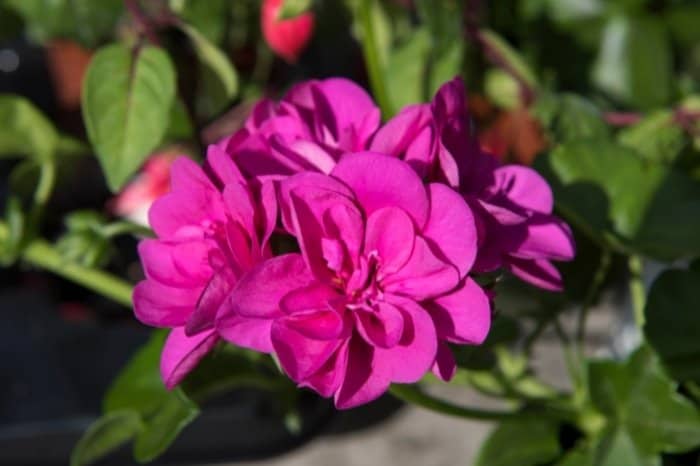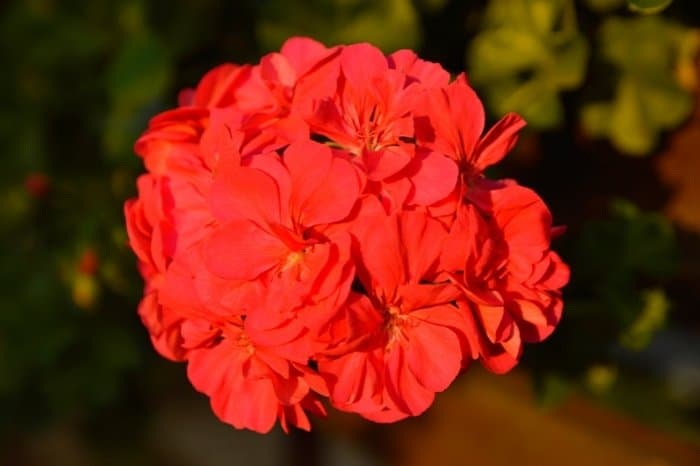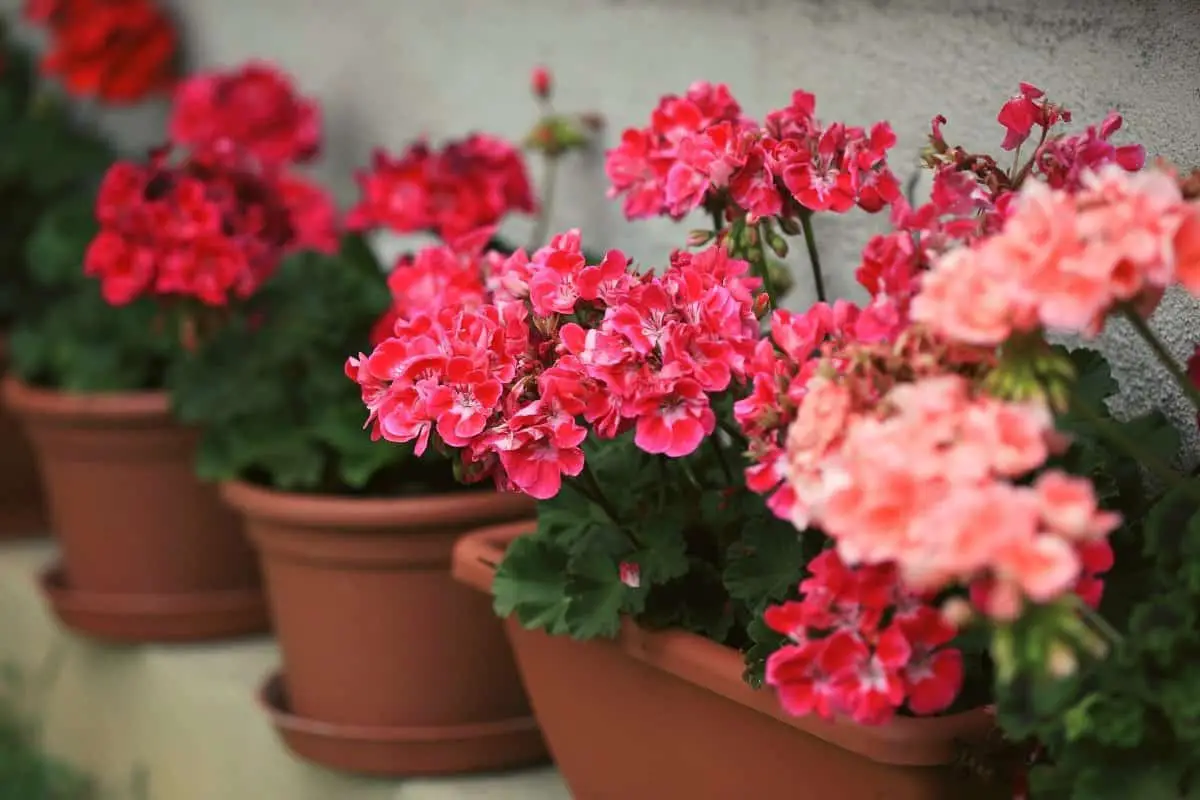Last Updated on February 18, 2022 by
Caring for geraniums in pots is significant in ensuring you provide them with the right growing conditions causing them to thrive.
Like all other plants (Pelargonium xhortorum) or geraniums have a good share of problems they face when growing. The issues range from seedlings damping off to tall thin plants.
Luckily, we can fix these problems easily if only we know the best practices involved when growing and caring for these plants. This is especially important when you choose to grow geraniums in pots.
In this post, we will share the best care for geraniums, including the problems they face. But, before that, let’s look at the type of geraniums you can grow in pots.
The Best Geranium Types To Grow In Pots
The best geranium types to grow in pots are those that have compact growth. These types have the best chances to succeed, and they include:
- Marble Gray (Pelargonium citronellum) – This type is best grown for foliage instead of flowers. Their foliage is highly fragrant and smells like rose, mint, lemon, chocolate or even cinnamon.
- Ivy-leafed Geraniums (Pelargonium peltatum) – Their leaves resemble ivy plant leaves and they have a trailing habit. They are commonly used in hanging window boxes and baskets.

- Zonal Geraniums or Common Geraniums (Pelargonium x hortorum) – This type has distinct leaf markings that include selections with silver leaves, tri-colored leaves, fancy leaves, and leaves with white markings. Their flower colors are usually red, pink, or white.
- Martha Washington Geraniums (Pelargonium x domesticum) – They flower in the winter and are available from many florists. Like the Mabel Gray type, they are not heat-tolerant and will not perform as well outdoors as the common geranium will.
Read more about Gorgeous Flowers Squirrels Won’t Eat
Growing And Caring For Geraniums In Pots
Starting From Seeds Vs. Planting Cuttings
Most geranium plants are grown from cuttings, while a good number are grown from seeds. You can start from sources indoors before transplanting them into pots. The biggest challenge that seedlings face is damping-off during germination.
To control this, ensure that you clean the containers used for starting seeds and ensure they have enough drainage. Wash your containers with soapy water and disinfect them by dipping them in a solution that contains one part chlorine and nine parts water. Do the same when propagating your geranium plants from cuttings.
Selecting Your Pots
Growing geraniums in pots require large containers, window boxes, or hanging boxes. There are two factors to consider when selecting the right pot. Consider the size of the geranium plant that should guide you to the size to use. Also, consider your pot’s drainage to ensure they are adequate to allow the water to flow freely.
HOMENOTE Plant Pots, Set of 15 Plastic Planters with Multiple Drainage Holes and Tray 6 inch
Choose Suitable Potting Soil
Geraniums are not very particular about the soil pH; however, choosing neutral to slightly acidic soil will be ideal. Also, these plants prefer potting soil that is well-draining, moist, and high in organic matter.
To achieve this kind of soil, work a 3-4-inch layer of organic matter such as peat moss or compost into the soil before planting. Besides, ensure the composition has a coarse material like sand or perlite. If this sounds too complicated to do, you can go for a professionally prepared commercial soil mix.
The advantage of using the commercial potting mixes is that they are natural and enhanced with my-tone that improves root development. However, if you choose this option, look out for fungus gnats, especially as you keep the soil moist.
Light And Temperature Exposure
These two conditions are essential aspects of any plant growth. To grow the best flowering and most vigorous geranium plants, place them under bright light. Some geranium types tolerate partial to full shade, but they won’t blossom as you would expect. If you don’t have adequate light in your area, the best option is to plant geranium.
You will need to grow your geraniums in temperatures ranging from 70 to 75 degrees during the day and 60 to 65 degrees at night.
If you fail to meet the requirements for light and temperature, your geraniums will grow tall and spindly. To help your geraniums produce bright blooms, allow them at least 6 hours of direct sun. The best location to plant your geraniums in the winter is south and west-facing windowsills.

Caring For Geraniums In Pots -Watering
Overall, potted plants require more frequent watering than typical garden plants. Therefore, water them as soon as the top inch of soil gets dry to the touch. Allow the soil to dry completely between watering schedules, then water it thoroughly. To help retain moisture and prevent weed growth, use mulch.
During the winter, the plant growth slows down; reduce the amount of water you give them but don’t let the roots dry out. Avoid overhead watering since it makes the foliage wet encouraging disease development.
Inspect your plant each day to ensure it has enough moisture. Geraniums respond positively to having the soil dry out between each watering. Ensure that you water only as needed, checking the soil for dryness to a depth of 4 to 6 inches.
Applying Fertilizers In Geraniums In Pots
Don’t fertilize the geranium plants until they are well established so that you don’t kill them. When you fertilize, use soluble or slow-release fertilizers, best for indoor plants.
Fertilize every 2 weeks using a water-soluble fertilizer at half strength. If your plants are growing under low light or indoors, reduce the amount of fertilizer. Always apply the fertilizer according to the labeled instructions and ensure your soil is always moist before applying.
The best fertilizer to use is a 20-20-20 liquid fertilizer. Use a rate of 2 tablespoons per gallon of water. However, read the instructions before use.
Pruning And Deadheading Your Geraniums
Geraniums give some the most beautiful flowers and deadheading the spent flowers only makes them better. Deadheading keeps them blooming all summer with new flowers each time you remove the spent ones.
Frequently remove the spent flower heads when they begin to wither and deteriorate to prevent seeds from forming, producing more blooms.
FAQs
How do you care for geraniums?
It is important to water your geraniums regularly, especially when the weather is hot and dry. This is because geraniums are drought tolerant and require very little water. If you live in an area that gets a lot of rain, then you can reduce the amount of water you use on your geraniums. Geraniums should not be placed too close to each other. It is recommended that you space them at least 6 inches apart from each other. You can grow them together in groups or in beds, but make sure that you don't have more than one bed of geraniums. Geraniums are known to attract butterflies and hummingbirds to the garden. They are also easy to care for and they grow well in containers as well.
If you live in an area with hot summers, then you may need to bring your plants indoors during the summer months.
If you want to use them indoors, you'll need a good, bright window and no drafts. I keep mine in a window with filtered sunlight. They like warmth, but if they get too warm, they'll bolt and you'll have to replant them.
How often should I water potted geraniums?
Geraniums need about 1 inch of water per week. Watering your geraniums more than once a week will cause the soil and roots to dry out and this will kill the plant.
The best way to water your geraniums is to use a soaker hose. This will keep the soil moist without saturating it. If you don't have a soaker hose, then use a watering can with a fine rose.
Water your geraniums in the early morning or late evening when the sun isn't shining because you will avoid the midday heat.
Do geraniums like sun or shade?
Geraniums are easy to grow and they do well in any sunny spot. You can also grow them in a pot on your porch or patio.
Sunlight is important for geraniums. In the spring, when new growth starts to appear, it is best to keep plants in full sun. When flowering, they will do well in partial shade and full sun. Water geraniums regularly, but not too often. Keep them evenly moist, and water deeply once or twice a week.
How long do geraniums last in pots?
The answer to this question will vary depending on the type of geranium, its soil, and how well-watered it is. To keep a geranium looking good, give it a weekly watering, especially in the warmer months. Watering geraniums regularly keeps them looking healthy, but also helps prevent them from becoming root bound. You can expect to see your geraniums bloom for up to four months each year. But even though your geraniums are out of season, they're still hardy plants that won't mind the cold.
In general, they can last for decades in pots.
Why are my geraniums drooping?
If the leaves are drooping, then your plants are not getting enough sunlight.
They are hardy perennials (meaning they live for more than one year) They have rosy flowers that bloom between April and June They are easy to grow, and require little maintenance Most geraniums can be grown as annuals, and some can be used as cut flowers or potted plants Geraniums are known for their drought tolerance, and can survive in poor soil.
Conclusion
FAQs
How do you care for geraniums?
It is important to water your geraniums regularly, especially when the weather is hot and dry. This is because geraniums are drought tolerant and require very little water. If you live in an area that gets a lot of rain, then you can reduce the amount of water you use on your geraniums. Geraniums should not be placed too close to each other. It is recommended that you space them at least 6 inches apart from each other. You can grow them together in groups or in beds, but make sure that you don't have more than one bed of geraniums. Geraniums are known to attract butterflies and hummingbirds to the garden. They are also easy to care for and they grow well in containers as well.
If you live in an area with hot summers, then you may need to bring your plants indoors during the summer months.
If you want to use them indoors, you'll need a good, bright window and no drafts. I keep mine in a window with filtered sunlight. They like warmth, but if they get too warm, they'll bolt and you'll have to replant them.
How often should I water potted geraniums?
Geraniums need about 1 inch of water per week. Watering your geraniums more than once a week will cause the soil and roots to dry out and this will kill the plant.
The best way to water your geraniums is to use a soaker hose. This will keep the soil moist without saturating it. If you don't have a soaker hose, then use a watering can with a fine rose.
Water your geraniums in the early morning or late evening when the sun isn't shining because you will avoid the midday heat.
Do geraniums like sun or shade?
Geraniums are easy to grow and they do well in any sunny spot. You can also grow them in a pot on your porch or patio.
Sunlight is important for geraniums. In the spring, when new growth starts to appear, it is best to keep plants in full sun. When flowering, they will do well in partial shade and full sun. Water geraniums regularly, but not too often. Keep them evenly moist, and water deeply once or twice a week.
How long do geraniums last in pots?
The answer to this question will vary depending on the type of geranium, its soil, and how well-watered it is. To keep a geranium looking good, give it a weekly watering, especially in the warmer months. Watering geraniums regularly keeps them looking healthy, but also helps prevent them from becoming root bound. You can expect to see your geraniums bloom for up to four months each year. But even though your geraniums are out of season, they're still hardy plants that won't mind the cold.
In general, they can last for decades in pots.
Why are my geraniums drooping?
If the leaves are drooping, then your plants are not getting enough sunlight.
They are hardy perennials (meaning they live for more than one year) They have rosy flowers that bloom between April and June They are easy to grow, and require little maintenance Most geraniums can be grown as annuals, and some can be used as cut flowers or potted plants Geraniums are known for their drought tolerance, and can survive in poor soil.
Caring for geraniums in pots is significant in getting the best results – a healthy bloom in summer.
Potted geraniums are excellent indoor plants that you can grow indoors all year round. They will flower continuously with the proper care and growing conditions, brightening your home in a colorful vibe.
Caroline is a gardener who loves to get down to the nitty–gritty of gardening. She proudly proclaims herself as a ‘dirt worshipper‘ and can often be found deep in the garden, covered in soil and singing to her plants. As a self–proclaimed ‘plant whisperer‘, Caroline believes that plants need love and attention just like any other living thing, and she loves to give them both. When she‘s not tending to her garden, you can often find her researching the latest gardening trends, or teaching others how to make their gardens thrive



